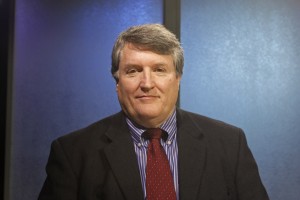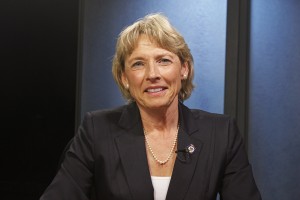Two experienced politicians are running against each other for Senate District N in south Anchorage and Girdwood — current senator Cathy Giessel, a Republican, and former state representative Harry Crawford, a Democrat. They bring to the ballot very different ideas about infrastructure development and education.
Both Giessel and Crawford arrived at the Alaska Public Media studios for their debate with binders of notes, calm and prepared. Both had been through it all before. Crawford served in the state house for 10 years before deciding to run against Don Young in 2010 and losing. Giessel has been in the state Senate since 2010. They both want to reduce the state’s budget and develop resources. And that’s where most of their similarities end.

Take the issue of roads. When asked what transportation infrastructure should be prioritized, Giessel focused on roads to mines in rural Alaska.
“Transportation is what allows industry and the economy to grow. And so it’s very important. We haven’t built a road in Alaska, a significant road, in many decades. I want to see that change,” she said during the program Running.
Crawford said railroads would be more cost effective for transporting ore, and work on roads needs to be local.
“The most dangerous thing that a resident of Girdwood does in their daily life is drive the highway between Potter March and Girdwood. We need a divided highway there. We need to start fixing that right now because we save lives when we do.”

They also disagree about the Alaska Stand Alone Pipeline, also known as the small gasline or the bullet line. Giessel says it’s a necessary backup plan for getting natural gas to Alaskans in case the LNG Project doesn’t go through.
Crawford says stopping the project would be one of the first ways he would trim the budget. “Certainly I would cut the money that goes into the bullet line. Because that’s certainly not something that will ever bring a return to Alaska because it’s not going to be built. You can’t make it pencil out.”
Crawford says putting more money into public education will pencil out in the long run. He supports increasing the Base Student Allocation and does not want public money going to private schools.
Giessel voted to increase the BSA last year, but she says just throwing more money at the school system isn’t the solution. “But the fact is, we need to innovate in education. We can’t keep doing the same thing and remain competitive on the world market of ideas.”
She says one way to do that is by supporting broadband for education in rural areas.
Giessel also says the cuts to the Anchorage School District were not drastic, a point she repeated several times during the debate. “It is a fact that only three teachers were not hired back by the Anchorage School District. It’s in their CAFR report [Comprehensive Annual Financial Report], any one can view that.”
Part of the statement is technically true but also misleading. The school district cut 13 classroom teaching positions because of a lack in funding from the state. An additional 44 were cut because of a decrease in enrollment over the past three years. That’s 57 teaching positions total. All but three teachers whose jobs were cut were moved to other openings. The district also cut 75 support staff positions, though some of those were vacant.
Giessel’s source is inaccurate. Heidi Embly from the school district says they won’t release the Comprehensive Annual Financial Report for this school year until next fall.
The two candidate’s funding sources reflect their differing stances as well. According to their 30-day reports, most of Giessel’s large campaign contributions came from Republican groups, business organizations, and resource development and support industry groups. Crawford’s contributions came from unions, public safety employees, and the Democrats.
Anne Hillman is the healthy communities editor at Alaska Public Media and a host of Hometown, Alaska. Reach her at ahillman@alaskapublic.org. Read more about Anne here.





